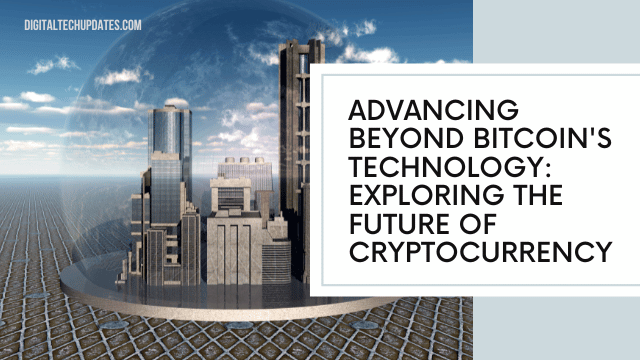Cryptocurrency enthusiasts are well-acquainted with Bitcoin, the pioneer of the digital currency revolution. Since its inception in 2009, Bitcoin has captivated the world with its promise of decentralized, peer-to-peer transactions. However, the crypto landscape is far from being a one-coin show. Altcoins, or alternative cryptocurrencies, have emerged as significant players in this space. In this article, we will explore how these innovative altcoins are pushing the boundaries of technology beyond Bitcoin’s foundation. In addition, if you are looking for a website that helps people learn about investments by connecting them with investment education companies that can help them receive the right information, you may visit http://trade-proair.com/.
Understanding Bitcoin’s Technology
To appreciate the innovations of altcoins, it’s essential to understand the building blocks laid by Bitcoin:
The Fundamentals of Blockchain Technology
At the core of Bitcoin and most altcoins lies the blockchain—a distributed ledger that records all transactions in a secure and immutable manner. This decentralized system provides transparency and security, eliminating the need for intermediaries.
Proof of Work (PoW) Consensus Mechanism
Bitcoin employs PoW, a mechanism that relies on miners solving complex mathematical puzzles to validate transactions. While PoW is secure, it faces scalability issues, limiting the number of transactions processed per second.
Bitcoin’s Scalability Challenges
As Bitcoin gained popularity, its scalability issues became apparent. With a maximum throughput of around 7 transactions per second (TPS), Bitcoin struggled to handle high transaction volumes, leading to slower confirmations and increased fees.
The Rise of Altcoins
Altcoins entered the scene as a response to Bitcoin’s limitations. They aimed to tackle diverse challenges and offer unique features:
Historical Context: Emergence of Altcoins
The first altcoin, Namecoin, debuted in 2011, followed by Litecoin and many others. These altcoins introduced various improvements and use cases.
Diverse Objectives: Smart Contracts, Privacy, Speed, and More
Altcoins diversified with specific goals. Some focused on smart contracts (like Ethereum), while others prioritized privacy (like Monero), speed (like Solana), or cross-border payments (like Ripple).
Notable Altcoins and Their Unique Features
Ethereum: Smart Contracts and DApps
Ethereum introduced the concept of smart contracts, self-executing contracts with the terms of the agreement directly written into code. Ethereum’s Virtual Machine (EVM) powers these smart contracts, enabling the development of decentralized applications (DApps).
Ripple (XRP): Cross-Border Payments and IoV
Ripple facilitates instant, low-cost cross-border payments, aiming to create an Internet of Value (IoV). It uses the Ripple Protocol Consensus Algorithm (RPCA) to achieve consensus and has formed partnerships with numerous financial institutions.
Cardano (ADA): Scalability and Sustainability
Cardano focuses on scalability and sustainability, utilizing the Ouroboros Proof of Stake (PoS) protocol. The project emphasizes research-driven development and peer-reviewed academic work.
Monero (XMR): Privacy-Focused
Monero employs ring signatures and stealth addresses to enhance transaction privacy. It prioritizes anonymity, making it difficult to trace transactions and account balances.
Solana (SOL): Speed and High Throughput
Solana offers unparalleled speed and throughput, thanks to its unique Proof of History (PoH) consensus mechanism. It supports a wide range of decentralized applications and projects.
Innovative Altcoins: A Deep Dive
Now, let’s delve deeper into some of these innovative altcoins:
Ethereum: Smart Contracts and DApps
Ethereum’s smart contracts enable decentralized applications (DApps) across various sectors, including finance, supply chain, and gaming. These DApps execute code autonomously, reducing the need for intermediaries.
Ripple (XRP): Cross-Border Payments and IoV
Ripple’s XRP token is designed to bridge different currencies and facilitate cross-border transactions. It aims to revolutionize the world of finance by enabling faster, cheaper, and more efficient global payments.
Cardano (ADA): Scalability and Sustainability
Cardano’s Ouroboros PoS protocol offers scalability and sustainability while addressing energy consumption concerns. It emphasizes a peer-reviewed approach to development, ensuring high-quality code.
Monero (XMR): Privacy-Focused Cryptocurrency
Monero’s focus on privacy is paramount. By employing ring signatures and stealth addresses, it conceals transaction details and provides users with complete financial privacy.
Solana (SOL): Speed and High Throughput Blockchain
Solana’s unique consensus mechanism, Proof of History (PoH), achieves impressive transaction speeds. Its scalability makes it ideal for decentralized applications with high transaction volumes.
Challenges and Innovations
While altcoins offer unique features, they face challenges:
Scalability Solutions in Altcoins
Altcoins are exploring various scalability solutions, including layer 2 solutions, sidechains, sharding, and parallel processing. These solutions aim to increase TPS and improve overall performance.
Regulatory Concerns and Compliance
Altcoins operate in a regulatory gray area in many jurisdictions. As governments worldwide develop cryptocurrency regulations, altcoin projects must navigate compliance issues to thrive.
Investing in Altcoins
Investors looking to enter the world of altcoins should consider several factors:
Factors to Consider When Investing in Altcoins
Investors should assess the technology, team, and development roadmap of altcoin projects. A strong foundation and clear vision are essential for long-term success.
Risks and Potential Rewards
Altcoin investments come with risks, including high volatility and market sentiment fluctuations. However, for those willing to do their due diligence, the potential rewards can be significant.
Conclusion
Innovative altcoins are reshaping the cryptocurrency landscape by pushing the boundaries of technology beyond Bitcoin’s original design. Understanding the strengths and weaknesses of these altcoins is crucial for anyone interested in the dynamic world of cryptocurrencies. As the crypto ecosystem continues to evolve, embracing innovation and diversification can lead to exciting opportunities and the advancement of blockchain technology as a whole.




